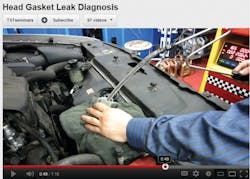Q: What is the most useful tool for finding an EVAP leak?
A: Some people check system pressures and look at PIDs on a scan tool, but it is safe to say that you cannot diagnose EVAP problems without a smoke machine. After all, isn't seeing believing? If you can see where the leak is, you will feel better about the repair and can more easily sell the customer on the job.
Now, not all smoke machines are equal. A good smoke machine will have a system pressure gauge so you can measure how large an EVAP leak is. This pressure gauge has measurements by thousandths of an inch. To make it simple, if you attach the smoke machine properly to the EVAP port under the hood (watch out, these are reverse thread) or to the gas tank and see a leak greater than 0.020" on older vehicles, you have an EVAP leak that will throw a code. On newer vehicles, look for 0.010" or less on the gauge. Remember to close the vent solenoid with a Power Probe or your scan tool's bidirectional controls, or you will see a false EVAP leak.
Some smoke machines come with a couple additional important features, namely leak detection dye (not just any UV dye, but an OEM-approved one that is safe to breath and does not damage diaphragms internal to solenoids on the system) and the ability to use CO2 instead of shop air. CO2 can be used as a safety precaution (because the oxygen in shop air can theoretically cause an explosion with fuel vapor), but from a diagnostic perspective it is important that it can be used with an emissions analyzer to find really tough EVAP leaks (see Fig. 1). We'll get more into that later.
Q: Is there a quick way to know if I have a vacuum leak?
A: Yes. First, you need to have a good reason to look for one. For example, if you have a P0171 or P0174, common sense dictates you should be checking for a vacuum leak. In order to verify this, you can simply look at Short Term Fuel Trim on your scan tool in Generic OBDII. Let the engine idle and then look for the numbers to be positive (over 7+ or more STFT Bank 1 or 2 is sufficient.) Now, go WOT (Wide Open Throttle). If STFT numbers go down after doing this test specificially, your lean issue is caused by a vacuum leak. You should follow up this test by connecting your smoke machine to a vacuum hose and smoke the whole system. This will help you find the origin of your lean issue (See Fig. 2).
Now, keep in mind this strategy works 90 percent of the time. Sometimes the lean issue only happens when the vehicle is cold, such as on recent Toyota Corollas where it's nearly impossible to spot a leaking intake manifold gasket.
Q: I used my pressure tester and can't find the antifreeze leak. Any ideas?
A: If you cannot find an antifreeze leak, you need to start suspecting a faulty head gasket. Let's illustrate this in a case study. Recently, a 2006 Mercury Grand Marquis was in the shop. Months ago a thermostat was replaced and a leaking intake manifold was spotted using a pressure tester.
All fixed, right? Wrong. Another few months later it formed another antifreeze leak. However, even after putting the vehicle on the lift and pressure testing it no leaks were to be found, but pressure decreased by a few PSI in less than five minutes.
So, it's a leaking head gasket, right? The symptoms make sense, as does the vehicle's history (the bad thermostat and previous leak caused overheating conditions that warped the head). Maybe you feel 90 percent confident that a new head gasket will fix the leak. But, what if your customer or you yourself want something better than 90 percent?
With the right tools, you can be 100 percent certain that you are dealing with a head gasket issue. Simply turn on your emissions analyzer and check the HC levels in the shop. The number should be close to zero. Then, open the radiator cap and make a tent around it with some shop rags. Put your analyzer's probe in your "tent" and see if HC levels soar. If they do, you confirmed that the head gasket is bad, because HC from the combustion chamber of the engine is now getting into the antifreeze. This, in turn, confirms that antifreeze is going into the combustion chamber and out the tail pipe (See Fig. 3).
In the old days you used to be able to see or smell that a vehicle was burning antifreeze. In 2012, catalytic converters are too good for that. The Grand Marquis' bad head gasket was diagnosed with an emissions analyzer. It was the only tool that could have done the job.
Q: What is the best way to diagnose a tough air suspension problem?
A: Typically, vehicles with air suspension have a combination of problems by the time they make it to your shop. It's not atypical to have a car which has a bad ride height level sensor, two bad air springs, and a bad compressor. Problems tend to come in bunches with these systems, but that's a discussion for another day.
The best way to begin diagnosing an air suspension problem is with a scan tool. To get the job done you need a factory scan tool or an aftermarket scan tool with factory capabilities.
Here's a small case study on a real-world problem car: On a 2004 BMW X5 with leaking rear air springs, you throw soapy water on the suspension and do not see any bubbles. So, you need to scan for codes to find out where to start your diagnosis. After being told to check the front right ride height level sensor by the tool, you should swap the front sensors to see if it's a sensor or wiring/module issue. If the code stays on the same sensor, immediately suspect the module. Being that more modules go bad than wiring, to test this presumption simply swap the signal wires of those sensors to the module and scan the vehicle. As you can see in the screenshots, the ride height values on the front right sensor remain static, even though it is, in fact, directly wired to the front left sensor. With the right scan tool and a little ingenuity you can diagnose that this vehicle had a bad module (See Fig. 4 and 5, much thanks to Bernard Tripp of Autohaus for devising this technique).
Another good strategy for tough-to-find leaks is to use a smoke machine and an emissions analyzer (See Fig. 6). You see, you can find a spot where you can insert CO2 into the vehicle and simply use your emissions analyzer to find spots where there are elevated levels of CO2. This will help you spot the leaking air spring or compressor check valve that you cannot find from another means (such as soapy water).


